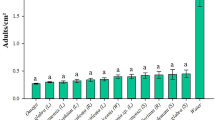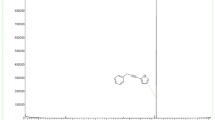Abstract
Nematotoxic effect of an aqueous extract of Artemisia annua and its components caffeic acid, chlorogenic acid (5-caffeoylquinic acid, 5-CQA), artemisinin and the related semi-synthetic artesunate, was investigated on the root-knot nematode Meloidogyne incognita and the potato cyst nematode Globodera rostochiensis and on the virus-vector dagger nematode Xiphinema index. Juveniles of M. incognita and G. rostochiensis and females of X. index were exposed to 500, 250 and 125 μl ml−1 solutions of the A. annua aqueous extract, caffeic acid, chlorogenic acid and artesunate and to 50 μl ml−1 solution of artemisinin for 2, 4, 8 and 24 h. Egg masses of M. incognita and cysts of G. rostochiensis were exposed for 24, 48, 96 h and 1 or 2 weeks only to the extract solutions. Aqueous extract was highly effective on G. rostochiensis juveniles, whereas M. incognita juveniles were affected only at long exposure times. Adversely, egg hatch inhibition was strong on M. incognita and poor or minimal on G. rostochiensis. Females of X. index were sensitive only to long exposures to the highest extract concentration. Both caffeic and chlorogenic acid did not affect juveniles of M. incognita but were highly active on G. rostochiensis juveniles and X. index females even at the lowest concentration. Artesunate toxicity was almost zero on M. incognita and low on X. index females, but high on G. rostochiensis juveniles. Artemisinin solution was lethal to more than 50 % of G. rostochiensis juveniles within 24 h, but did not affect M. incognita juveniles and X. index females. Results suggest different roles of the tested compounds in the biocidal activity on each target nematode species. The extract of A. annua and its main phytochemicals seem to have a potential to be developed into new nematicidal formulates, though their activity should be validated in the soil.



Similar content being viewed by others
References
Akhtar, M., & Malik, A. (2000). Roles of organic soil amendments and soil organisms in the biological control of plant-parasitic nematodes: a review. Bioresource Technology, 74, 35–47.
Al-Banna, L., Darwish, R. M., & Aburjai, T. (2003). Effect of plant extracts and essential oils on root-knot nematode. Phytophathogia Mediterranea, 42, 123–128.
Argentieri, M. P., D’Addabbo, T., Tava, A., Agostinelli, A., Jurzysta, M., & Avato, P. (2008). Evaluation of nematicidal properties of saponins from Medicago spp. European Journal of Plant Pathology, 120, 189–197.
Balint, G. B. (2001). Artemisinin and its derivatives. An important new class of antimalarial agents. Pharmacology & Therapeutics, 90, 261–265.
Bhakuni, R. S., Jain, D. C., Sharma, R. P., & Kumar, S. (2001). Secondary metabolites of Artemisia annua and their biological activity. Current Science, 80, 35–48.
Carbonara, T., Pascale, R., Argentieri, M. P., Papadia, P., Fanizzi, F. P., Villanova, L., & Avato, P. (2012). Phytochemical analysis of a herbal tea from Artemisia annua L. Journal of Pharmaceutical and Biomedical Analysis, 62, 79–86.
Chitwood, D. J. (2002). Phytochemical based strategies for nematode control. Annual Review of Phytopathology, 40, 221–249.
Clarke, A. J., & Shepherd, A. M. (1968). Hatching agents for the potato cyst-nematode, Heterodera rostochiensis Woll. Annals of Applied Biology, 61, 139–149.
D’Addabbo, T., Avato, P., & Tava, A. (2009). Nematicidal potential of materials from Medicago spp. European Journal of Plant Pathology, 125, 39–49.
D’Addabbo, T., Carbonara, T., Leonetti, P., Radicci, V., Tava, A., & Avato, P. (2011). Control of parasitic nematodes with active saponins and biomass from Medicago sativa. Phytochemistry Reviews, 10, 503–519.
Davies, K. G., & Curtis, R. H. C. (2011). Cuticle surface coat of plant-parasitic nematodes. Annual Review of Phytopathology, 49, 135–156.
De Donno, A., Grassi, T., Idolo, A., Guido, M., Papadia, P., Caccioppola, A., Villanova, L., Merendino, A., Bagordo, F., & Fanizzi, F. P. (2012). First-time comparison of the in vitro antimalarial activity of Artemisia anna herbal tea and artemisinin. Transactions of the Royal Society of Tropical Medicine and Hygiene. doi:10.1016/j.trstmh.2012.07.008.
Dias, C. R., Schwan, A. V., Ezequiel, D. P., Sarmento, M. C., & Ferraz, S. (2000). Efeito de extractos aquosos de plantas medicinais na sobrevivencia de juvenis de Meloidogyne incognita. Nematologia Brasileira, 24, 203–210.
Ferreira, J.F.S., Ritchey, K.D., Cassida, K.L., Turner, K.E., Gonzalez, J.M. (2006). Agrotechnological aspects of the antimalarial plant Artemisia annua and its potential use in animal health in Appalachia. Revue des Régions Arides, 797–804
Ferris, H., & Zheng, L. J. (1999). Plant sources of Chinese herbal remedies: effects on Pratylenchus vulnus and Meloidogyne javanica. Journal of Nematology, 31, 241–263.
Finney, D. J. (1978). Statistical method in biological assay. Statistical method in biological assay. London: Griffin.
Hooper, D. J., Hallmann, J., & Subbotin, S. A. (2005). Methods for extraction, processing and detection of plant and soil nematodes. In Sikora & Bridge (Ed.), Plant parasitic nematodes in subtropical and tropical agriculture (pp. 53–86). Wallingford, UK: CAB International.
Hussey, R. S., & Barker, K. R. (1973). A comparison of methods of collecting inocula of Meloidogyne spp., including a new technique. Plant Disease Reporter, 57, 1025–1028.
Hynes, R. K., & Boyetchko, S. M. (2006). Research initiatives in the art and science of biopesticide formulations. Soil Biology and Biochemistry, 38, 845–849.
Korayem, A. M., Hasabo, S. A., & Ameen, H. H. (1993). Effects and mode of action of some plant extracts on certain plant-parasitic nematodes. Journal of Pest Science, 66, 32–36.
Krishna, S., Uhlemann, A.-C., & Haynes, R. K. (2004). Artemisinins: their growing importance in medicine. Drug Resistance Update, 7, 233–244.
Krishna, S., Bustamante, L., Haynes, R. K., & Staines, H. M. (2008). Artemisinins: mechanisms of action and potential for resistance. Trends in Pharmacological Science, 29, 520–527.
Li, Y., Huang, H., Wu, Y-L. (2000). Qinghaosu (Artemisinin)—A fantastic antimalarial drug from a traditional Chinese medicine. In Liang & Fang (Eds.), Medicinal chemistry of bioactive natural products. Wiley, pp. 183–256.
Marco, J.A., Barbera, O. (1990). Natural products from the genus Artemisia L. In Atta-ur-Rahman (Ed.), Studies in natural products chemistry. Wiley & Sons, pp. 201–263.
Marinova, E. M., Toneva, A., & Yanishlieva, N. (2009). Comparison of the antioxidative properties of caffeic and chlorogenic acids. Food Chemistry, 114, 1498–1502.
Meshnick, S. R. (2002). Artemisinin: mechanisms of action, resistance and toxicity. International Journal of Parasitolology, 32, 1655–1660.
Ntalli, N. G., & Caboni, P. (2012). Botanical nematicides: a review. Journal of food and agricultural chemistry, 60, 9929–9940.
O’Neill, P. M., Barton, V. E., & Ward, S. A. (2010). The molecular mechanism of action of artemisinin—The debate continues. Molecules, 15, 1705–1721.
Pandey, R. (1990). Studies on phytonematotoxic properties in the extract of some medicinal and aromatic plants. International Nematology Network Newsletter, 7, 19–20.
Perry, R. N., & Moens, M. (2011). Introduction to plant-parasitic nematodes; modes of parasitism. Genomics and Molecular Genetics of Plant-Nematode Interactions, 3–20.
Regulation EC No 1095/2007 of the European Parliament and of the Council of Europe. http://eur-lex.europa.eu/.
Regulation EC No 396/2005 of the European Parliament and of the Council of Europe. http://eur-lex.europa.eu/.
Sato, Y., Itagaki, S., Kurokawa, T., Ogura, J., Kobayashi, M., Hirano, T., Sugawara, M., & Iseki, K. (2011). In vitro and in vivo antioxidant properties of chlorogenic acid and caffeic acid. International Journal of Pharmacology, 403, 136–138.
Seinhorst, J. W., & den Ouden, H. (1966). An improvement of Bijloo’s Method for determining the egg content of Heterodera Cysts. Nematologica, 12, 170–171.
Shakil, N. A., Prasad, D., Saxena, D. B., & Gupta, A. K. (2004). Nematicidal activity of essential oils of Artemisia annua against root-knot and reniform nematodes. Annals of Plant Protection Sciences, 12, 403–408.
Tan, R. X., Zhang, W. F., & Tang, H. Q. (1998). Biologically active substances from the genus Artemisia. Planta Medica, 64, 293–302.
Trudgill, D. L., & Blok, V. C. (2001). Apomistic, polyphagus root-knot nematode. Annual Review of Phytopathology, 39, 53–77.
Turner, S. J., & Evans, K. (1998). The origin, global distribution and biology of potato cyst nematodes (Globodera rostochiensis Woll. and Globodera pallida Stone). In R. J. Marks & B. B. Brodie (Eds.), Potato cyst nematodes—biology, distribution and control (pp. 7–26). Wallingford, UK: CAB International.
UNEP, United Nations Environment Programme. (2000). The Montreal protocol on substances that deplete the ozone layer.
van Zyl, S., Vivier, M. A., & Walker, M. A. (2012). Xiphinema index and its relationship to grapevines: a review. South African Journal of Enology and Viticulture, 33(1).
Willcox, M., Bodeker, G., Bourdy, G., Dhingra, V., Falquet, J., Ferreira, J. F. S., Graz, B., Hirt, H.-M., Hsu, E., de Magalhães, P. M., Provendier, D., & Wright, C. W. (2004). Artemisia annua as a traditional herbal antimalarial. In M. L. Willcox, G. Bodeker, & P. Rasoanaivo (Eds.), Traditional medicinal plants and malaria (pp. 43–59). Boca Raton, FL: CRC Press.
Yeats, G. W., Bongers, T., De Goede, R. G. M., Freckman, D. W., & Georgieva, S. S. (1993). Feeding habits in soil nematode families and genera—An outline for soil ecologists. Journal of Nematology, 25, 315–331.
Acknowledgments
This research was financially supported by Regione Puglia under “Progetto Strategico CIP PS_070”. T. Carbonara acknowledges Regione Puglia for financial support in a form of a grant. The Authors are also grateful to Dr. F. Grasso and Dr. M. Scarcella (CRA-Istituto Sperimentale per i Tabacchi, Monteroni, Lecce) for valuable assistance to grow A. annua plants. Thanks are also due to Prof. F.P. Fanizzi (University of Salento, Lecce) for valuable discussion.
Author information
Authors and Affiliations
Corresponding author
Rights and permissions
About this article
Cite this article
D’Addabbo, T., Carbonara, T., Argentieri, M.P. et al. Nematicidal potential of Artemisia annua and its main metabolites. Eur J Plant Pathol 137, 295–304 (2013). https://doi.org/10.1007/s10658-013-0240-5
Accepted:
Published:
Issue Date:
DOI: https://doi.org/10.1007/s10658-013-0240-5




